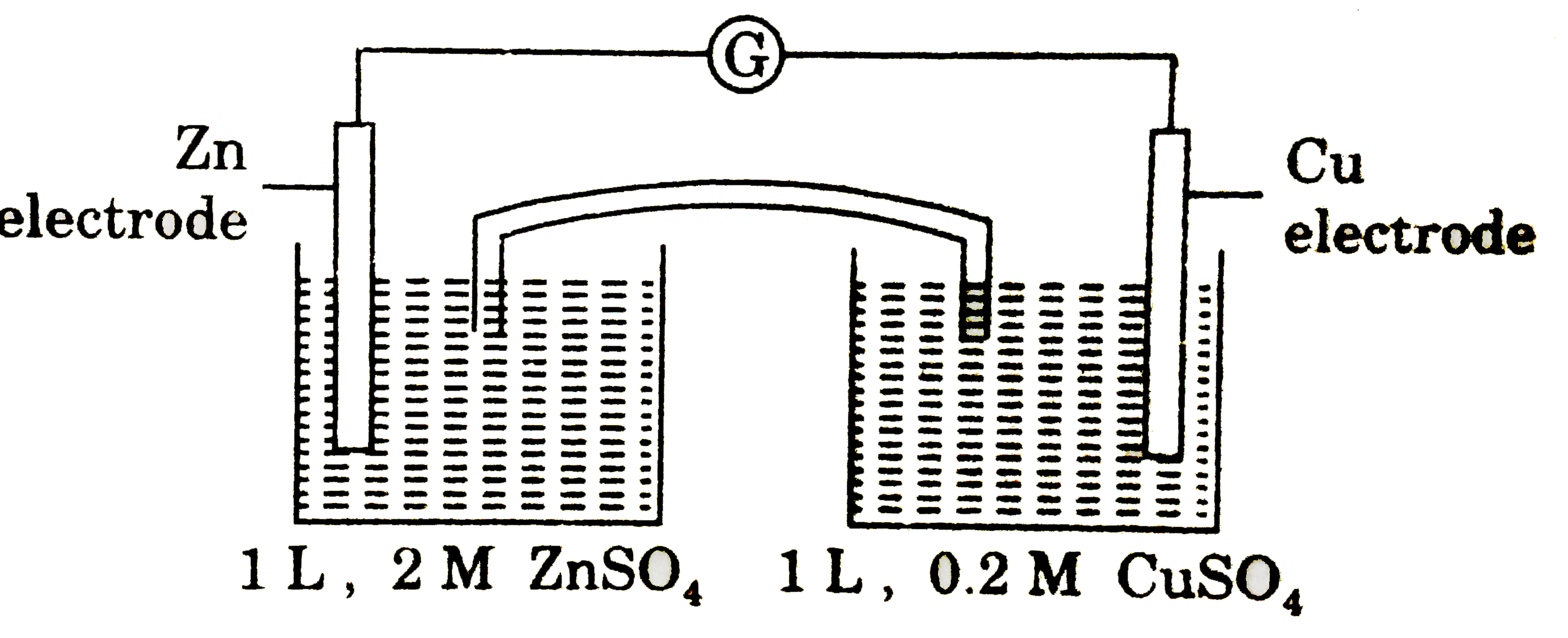If E∘Cu2+∣Cu=0.34V and E∘Cu2+∣Cu+=0.15V then the value for disproportion for Cu+ is :
(−0.19V)
(−0.38V)
(0.94)
(0.38V)
The correct Answer is:D
To find the value for the disproportionation potential of Cu+, we can follow these steps:
Step 1: Understand the Reactions
We have two half-reactions involving copper:
1. The reduction of Cu2+ to Cu:
Cu2++2e−→Cu(E∘=0.34V)
2. The reduction of Cu2+ to Cu+:
Cu2++e−→Cu+(E∘=0.15V)
The disproportionation reaction for Cu+ can be represented as:
2Cu+→Cu2++Cu
Step 2: Write the Gibbs Free Energy Change Equations
The Gibbs free energy change (ΔG) for each half-reaction can be calculated using the formula:
ΔG=−nFE∘
where n is the number of moles of electrons transferred and F is Faraday's constant.
For the first reaction (reduction of Cu2+):
ΔG1=−2F(0.34)
For the second reaction (reduction of Cu2+):
ΔG2=−F(0.15)
Step 3: Set Up the Disproportionation Reaction
For the disproportionation reaction, we can express its Gibbs free energy change as:
ΔGdisproportionation=ΔG1−2ΔG2
Substituting the values from above:
ΔGdisproportionation=(−2F(0.34))−(−F(0.15))
=−2F(0.34)+F(0.15)
=−2F(0.34)+F(0.15)
Step 4: Calculate the Disproportionation Potential
Now, we can express the overall Gibbs free energy change in terms of the standard potential for the disproportionation reaction:
ΔGdisproportionation=−nFE∘disproportionation
For the disproportionation of Cu+, n=1:
−2F(0.34)+F(0.15)=−FE∘disproportionation
Dividing through by −F:
E∘disproportionation=2(0.34)−0.15
=0.68−0.15
=0.53V
Step 5: Final Calculation
Thus, the value for the disproportionation potential of Cu+ is:
E∘disproportionation=0.53V
Summary
The value for the disproportionation potential of Cu+ is 0.53V.
We have two half-reactions involving copper:
1. The reduction of Cu2+ to Cu:
Cu2++2e−→Cu(E∘=0.34V)
2. The reduction of Cu2+ to Cu+:
Cu2++e−→Cu+(E∘=0.15V)
2Cu+→Cu2++Cu
The Gibbs free energy change (ΔG) for each half-reaction can be calculated using the formula:
ΔG=−nFE∘
where n is the number of moles of electrons transferred and F is Faraday's constant.
ΔG1=−2F(0.34)
ΔG2=−F(0.15)
For the disproportionation reaction, we can express its Gibbs free energy change as:
ΔGdisproportionation=ΔG1−2ΔG2
ΔGdisproportionation=(−2F(0.34))−(−F(0.15))
=−2F(0.34)+F(0.15)
=−2F(0.34)+F(0.15)
Now, we can express the overall Gibbs free energy change in terms of the standard potential for the disproportionation reaction:
ΔGdisproportionation=−nFE∘disproportionation
For the disproportionation of Cu+, n=1:
−2F(0.34)+F(0.15)=−FE∘disproportionation
E∘disproportionation=2(0.34)−0.15
=0.68−0.15
=0.53V
Thus, the value for the disproportionation potential of Cu+ is:
E∘disproportionation=0.53V
The value for the disproportionation potential of Cu+ is 0.53V.
Similar Questions
Knowledge Check
E∘Cu2+/Cu=0.34V
E∘Cu+/Cu=0.522V
E∘Cu2+/Cu+=A0.158B-0.158C1.182D-0.182If Cu2++2e→Cu,E∘=0.337v,Cu2++e→Cu,
E∘=0.153v then E∘ for the reaction Cu++e→Cu will beA0.52vB0.50vC0.30vD0.38vGiven:
(i) Cu2++2e−→Cu,E∘=0.337V
(ii) Cu2++e−→Cu+,E∘=0.153V
Electrode potential, E∘ for the reaction, Cu++e−→Cu, will beA0.90VB0.30VC0.38VD0.52V
Given:
(i) Cu2++2e−→Cu,E∘=0.337V
(ii) Cu2++e−→Cu+,E∘=0.153V
Electrode potential, E∘ for the reaction, Cu++e−→Cu, will be
View SolutionThe standard potential E∘ for the half reactions are as :
Zn→Zn2++2e−,E∘=0.76V
Cu→Cu2++2e−,E∘=−0.34V
The standard cell voltage for the cell reaction is ?
Zn+Cu2→Zn2++Cu
View SolutionCu2++2e−→Cu,E∘+0.34V
Cu2++e−→Cu+,E∘=+0.15V
The equilibrium constant for the reaction Cu+Cu2+→2Cu+ at 25∘C
View SolutionThe standard reduction potential E for the half reactions are as:
Zn2++2e−→Zn E∘=−0.76V
Cu2++2e−→Cu,E∘=0.34V
The standard cell voltage for the cell reaction is?
Zn+Cu2+→Zn2++Cu
View Solution
[Given:
E∘Zn2+∣Zn=−.0.76VKf[Cu(NH3)4]+2=4×1011
E∘Cu2+∣Cu=0.34V
At what conc. Of Cu+2, emf of the cell will be zero (at 298K) at conc. Of Zn+2 is remaining same?
View Solution

